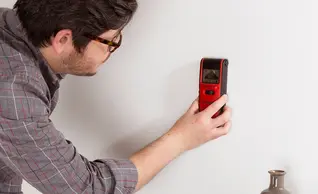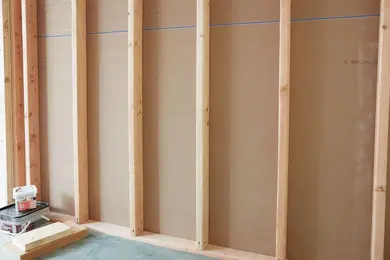In this comprehensive guide, we explore the importance and crucial steps involved in finding studs for a TV installation. We also go over potential issues that may arise if not done correctly, various methods for locating studs, and different types of studs that may be found in your home, along with the appropriate fasteners needed for each type. Whether you're a seasoned DIY enthusiast or a first-time homeowner, accurately locating studs is essential to ensure safety and stability when mounting your TV.
By
Madison Brown
|
April 8, 2024
.jpg)

In this comprehensive guide, we explore the importance and crucial steps involved in finding studs for a TV installation. We also go over potential issues that may arise if not done correctly, various methods for locating studs, and different types of studs that may be found in your home, along with the appropriate fasteners needed for each type. Whether you're a seasoned DIY enthusiast or a first-time homeowner, accurately locating studs is essential to ensure safety and stability when mounting your TV.
.jpg)
Are you ready to elevate your home entertainment experience by mounting your TV on the wall? Before you grab your tools and start drilling, it's crucial to locate the studs in your wall to ensure a secure and stable mount. Finding studs is an essential step in the TV installation process to ensure safety and stability. It can be easier than you think, especially with the right techniques and tools at your disposal. In this comprehensive guide, we'll walk you through everything you need to know about finding studs for a TV installation, whether you're a seasoned DIY enthusiast or a first-time homeowner looking to enhance your living space.
Studs are the vertical wood or metal beams behind your walls that provide structural support. When mounting a TV, it's essential to anchor it securely to studs to prevent accidents and ensure stability. Ideally, you should always install your bracket onto two studs. We recommend calling a professional if only one stud is located where you want to install your television.
Attempting to install a TV solely on drywall without securing it into the studs can lead to several issues. The drywall may not be able to support the weight of the TV over time, causing it to sag or even collapse, potentially damaging the TV and posing a safety hazard. Additionally, without proper anchoring, the TV mount might not be stable, leading to the TV being wobbly or even falling off the wall unexpectedly. Furthermore, there's a risk of damaging the drywall itself, as the weight of the TV puts strain on the wall material. To avoid these problems, it's crucial to mount the TV into the studs for adequate support and stability.

Absolutely! When its time to mount your TV, it's crucial to drill directly into the centre of the studs to ensure a secure and stable installation. You should use two studs per installation on each side of your bracket. Using drywall anchors or mounting directly onto drywall without anchoring to studs can compromise the integrity of the mount, leading to potential damage and safety hazards.

While a stud finder can significantly simplify the process of finding studs, it's not always necessary, especially if you're comfortable using alternative methods like the knock test or visual inspection. However, for precision and efficiency, investing in a stud finder is highly recommended, particularly if you plan to tackle multiple home improvement projects.
Studs are structural components in a wall that provide support for the wall surface and any loads placed upon it. There are primarily two types of studs used in construction: wood studs and metal studs.
Wood studs, also known as timber studs, are the traditional choice for framing walls in residential and commercial construction. They are typically made from dimensional lumber, such as 2x4s or 2x6s, and are commonly spaced either 16 or 24 inches apart. Wood studs are relatively easy to work with, can be cut to custom lengths, and provide good insulation properties. However, they may be susceptible to rot, insect damage, and warping over time if not properly treated or maintained.
Fasteners Needed: When mounting objects to wood studs, the common fastener is wood screws.
Wood screws are typically preferred for heavier items like shelving units or large mirrors, as they offer a secure hold and are less likely to pull out over time. These screws come in various lengths and gauges, so it's essential to choose the appropriate size based on the thickness of the material being mounted and the depth of the stud.
Additionally, nails can be used for lighter items or temporary installations. Common nails or finishing nails are suitable for securing objects to wood studs, but it's crucial to drive them in at a slight angle to prevent them from slipping out. Pre-drilling pilot holes slightly smaller than the diameter of the screw or nail can also help prevent splitting the wood.

Metal studs, on the other hand, are made from galvanized steel and have become increasingly popular in modern construction due to their durability, uniformity, and non-combustible nature. Metal studs come in various gauges and sizes, and they are typically lighter and straighter than wood studs. They are often used in commercial buildings, but they are also gaining popularity in residential construction. If you live in a high rise apartment building, your framing will either by metal studs or concrete. Metal studs are resistant to fire, moisture, and pests, making them a preferred choice in certain environments. However, they can be more challenging to work with than wood studs, requiring specialized tools and techniques for cutting and fastening. Additionally, metal studs may conduct heat and cold more readily than wood studs, which can affect energy efficiency if not properly insulated.
Fasteners Needed: When attaching objects to metal studs, self-tapping screws are the primary fasteners used due to the hardness of the steel (we recommend "Toggle Bolts").
These screws have a sharp, pointed tip that allows them to cut their threads as they are driven into the metal, providing a secure hold. Self-tapping screws for metal studs typically have a fine thread and a pan or flat head. It's essential to choose screws specifically designed for metal stud applications to ensure they provide sufficient strength and resistance to stripping. Additionally, for heavier items or applications where significant weight will be supported, it may be necessary to use anchors designed for metal studs, such as toggle bolts or anchor straps, to distribute the load more evenly and prevent the screws from pulling out.

In addition to metal and wood studs, several alternative framing methods are used in construction, each offering unique advantages depending on the project's requirements. It is very important to note that each wall type requires a specific fastener and many times drill to perform a secure and correct installation
Note: these additional wall types do not have studs and will need to know that during the installation

While stud finders are invaluable tools for locating studs behind walls, they may inadvertently detect other items that could pose potential issues if drilled into. This could lead to thousands of dollars of damage so its important to know what to look for and have second checks before drilling.
One common concern is the detection of electrical wiring. Modern homes are typically wired with electrical cables running through the walls, and these wires can be inadvertently pierced if care isn't taken during drilling. Accidentally drilling into electrical wiring can not only damage the wiring itself but also pose a serious safety hazard, potentially leading to electrical shocks, short circuits, or even fires. It's crucial to exercise caution and use non-invasive methods, such as a voltage detector, to confirm the presence of live wires before drilling.
Another item that stud finders may detect behind walls is plumbing pipes. Water supply pipes, drainpipes, and other plumbing components are often routed through walls, especially in bathrooms, kitchens, and utility areas. Drilling into a water pipe can result in leaks, water damage, and costly repairs. Additionally, piercing a drainpipe can release foul-smelling wastewater and create unsanitary conditions. To avoid drilling into plumbing pipes, it's essential to use caution and, if possible, consult plumbing diagrams or employ specialized tools like pipe locators before drilling.
Furthermore, stud finders may detect other hidden elements within walls, such as ductwork, HVAC components, or structural reinforcements. Drilling into ducts or HVAC components can disrupt airflow, compromise heating and cooling efficiency, and necessitate expensive repairs. Similarly, inadvertently drilling into structural reinforcements, such as metal braces or beams, can weaken the integrity of the building and compromise its stability. Before drilling into walls, it's advisable to use additional methods, such as visual inspections or professional consultations, to identify and avoid these potential hazards. Taking these precautions can help prevent costly damage, ensure safety, and preserve the structural integrity of the building.

Hiring a professional TV installation company is important if you want to limit any issues, particularly considering the various risks associated with mounting a TV. Professionals possess the expertise and specialized tools necessary to ensure that the installation is conducted safely and securely. They can accurately locate studs without damaging electrical wiring, plumbing pipes, or other hidden elements within walls, mitigating the risk of costly repairs or safety hazards. Moreover, professional installers are well-versed in building codes and regulations, ensuring that the installation meets all necessary standards for structural integrity and safety. By entrusting the task to a reputable TV installation company like Auxe, individuals can have peace of mind knowing that their TV will be mounted securely and efficiently, without compromising the integrity of their home or risking potential hazards.

Mounting your TV on the wall is an exciting way to elevate your home entertainment experience, but it requires careful attention to detail to ensure a safe and secure installation. Finding studs is a critical step in this process, as it provides the necessary support and stability for your TV mount. Whether you're a seasoned DIY enthusiast or a first-time homeowner, understanding the importance of locating studs and employing the right techniques and tools is essential. From using stud finders to performing second checks and selecting appropriate fasteners for wood or metal studs, each aspect contributes to a successful installation.
Moreover, being aware of potential hazards behind walls, such as electrical wiring, plumbing pipes, and HVAC components, underscores the importance of hiring a professional TV installation company to mitigate risks and ensure a seamless process. By taking the time to find studs accurately and following best practices, you can enjoy a safe, reliable, and aesthetically pleasing TV mount that enhances your living space for years to come. Ready to embark on your TV mounting journey? Contact us today to schedule a professional installation service and take your home entertainment setup to the next level!
Ready to mount your TV? Book with us today to schedule a professional installation service and elevate your home entertainment setup to the next level!
.jpg)








.webp)
Our online price calculator is free and requires no credit card, email, or contact information. Check it out!
Our online price calculator is free and requires no credit card, email, or contact information. Check it out!